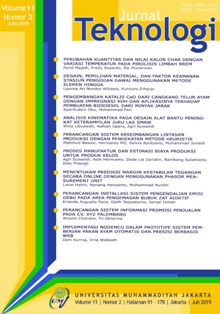DESAIN, PEMILIHAN MATERIAL, DAN FAKTOR KEAMANAN STASIUN PENGISIAN GAWAI MENGGUNAKAN METODE ELEMEN HINGGA
Main Article Content
Abstract
Downloads
Article Details
COPYRIGHT POLICY
The author(s) of an article published in the Jurnal Teknologi retains ownership of the intellectual property rights in work (s).
PUBLISHING RIGHTS
The author(s) of an article published in the Jurnal Teknologi have unrestricted publication rights. The authors give the Jurnal Teknologi the right to publish the article and designate the Faculty of Engineering Universitas Muhammadiyah Jakarta Publishing as the original publisher of the article.
LICENSING POLICY
Journal of Mechanical Engineering and Sciences is an open-access journal that follows the Creative Commons Non-Commercial 4.0 International License (CC BY-NC 4.0), which states that:

Under this license, the reusers must give appropriate credit, provide a link to the license, and indicate if changes were made. Users may do so in any reasonable manner, but not in any way that suggests the licensor endorses users or their use.
Please take the time to read the whole license agreement (https://creativecommons.org/licenses/by-nc/4.0/). As long as reusers follow the license conditions, the owner cannot withdraw these freedoms. The following components are included under this license:
 Attribution: Users must provide appropriate attribution, including a link to the license, and indicate whether or not they made any modifications. Users are free to do so reasonably, but not in a manner that indicates the licensee approves of their usage.
Attribution: Users must provide appropriate attribution, including a link to the license, and indicate whether or not they made any modifications. Users are free to do so reasonably, but not in a manner that indicates the licensee approves of their usage.
 NonCommercial: Users may not use the material for commercial purposes.
NonCommercial: Users may not use the material for commercial purposes.
References
Diniardi, E., Ramadhan, A. I., & Basri, H. (2014). Analisis Kekuatan Mekanik dan Struktur Mikro Pada Material Polimer Penyusun Kipas Radiator. Jurnal Teknologi, 6(1), 55–67. https://doi.org/10.24853/jurtek.6.1.55-67
Fu, S., Wang, Y., & Wang, Y. (2009). Tension testing of polycarbonate at high strain rates. Polymer Testing, 28(7), 724–729. https://doi.org/10.1016/j.polymertesting.2009.06.002
Ginting, E. M., Bukit, N., Siregar, M. A., & Frida, E. (2017). Struktur dan morfologi nano komposit campuran zeolit abu sekam padi. Jurnal Material Dan Energi Indonesia, 07(01), 18–23.
Komunikasi, K. (2015). Indonesia Raksasa Teknologi Digital Asia. Online. Retrieved from https://kominfo.go.id/content/detail/6095/indonesia-raksasa-teknologi-digital-asia/0/sorotan_media
Kumar, B. R. B., Doddamani, M., Zeltmann, S. E., Gupta, N., Ramesh, M. R., & Ramakrishna, S. (2015). Processing of cenosphere/HDPE syntactic foams using an industrial scale polymer injection molding machine. JMADE. https://doi.org/10.1016/j.matdes.2015.12.052
V. Dobrovolsky, K. Z. (1978). Machine elements : a textbook. Moscow: Peace Publisher.
Vidosic, J. P. (1957). Machine Design Projects. Ronald Press Co.
Wibawa, L. A. N. (2018a). Merancang Komponen Roket 3D dengan Autodesk Inventor Professional 2017. Buku Katta. Retrieved from https://play.google.com/books/reader?id=qHpKDwAAQBAJ&lr=&printsec=frontcover
Wibawa, L. A. N. (2018b). Simulasi Kekuatan Komponen Sarana Pengujian Roket Menggunakan Autodesk Inventor Professional 2017. Buku Katta. Retrieved from https://play.google.com/books/reader?id=BD1LDwAAQBAJ&hl=id&lr=&printsec=frontcover
Wibawa, L. A. N. (2019). Desain dan Analisis Kekuatan Rangka Tempat Sampah di Balai LAPAN Garut Menggunakan Metode Elemen Hingga. Turbulen: Jurnal Teknik Mesin, 1(2), 64–68.
Wibawa, L. A. N., & Himawanto, D. A. (2018). Analisis Ketahanan Beban Dinamis Material Turbin Angin Terhadap Kecepatan Putar Rotor (Rpm) Menggunakan Metode Elemen Hingga. Jurnal Simetris, 9(2), 803–808. https://doi.org/10.24176/simet.v9i2.2343
Younis, W. (2010). Up and running with Autodesk Inventor Simulation 2011: a step-by-step guide to engineering design solutions. Elsevier.

